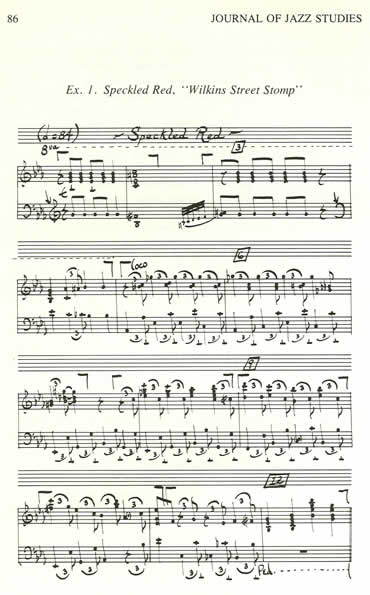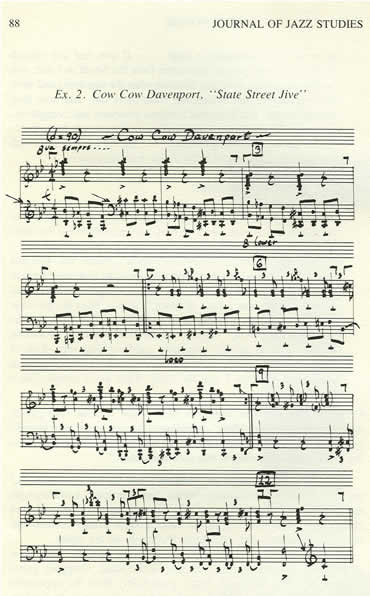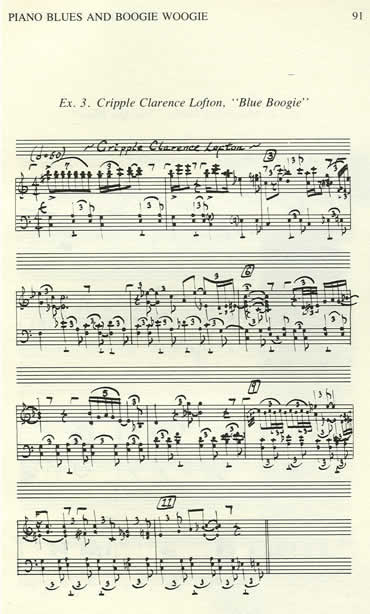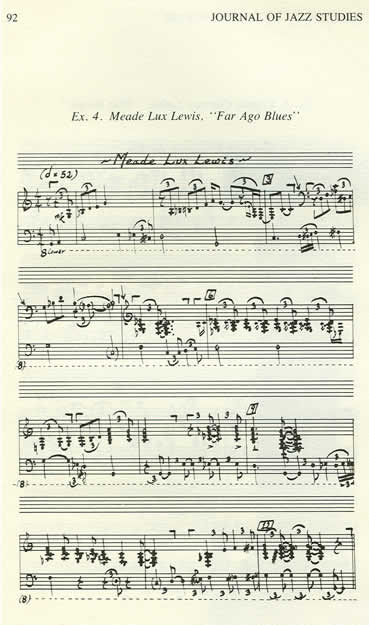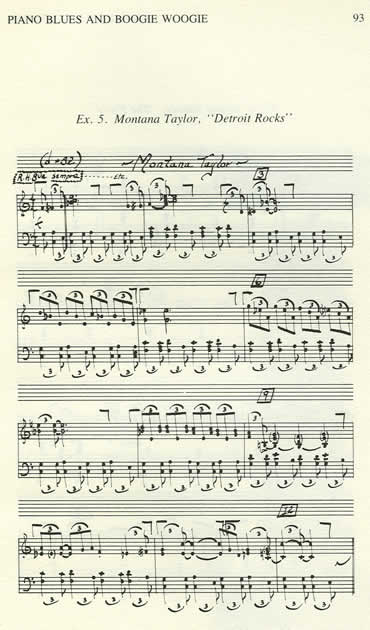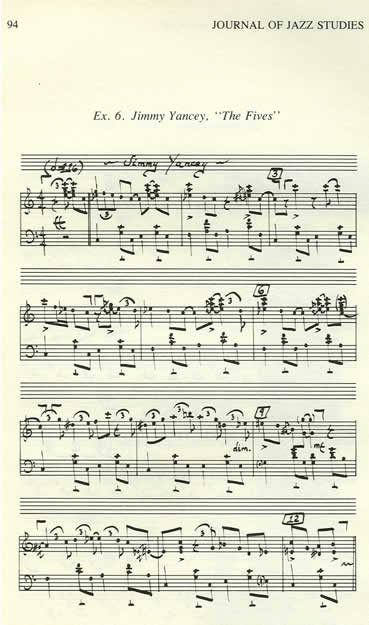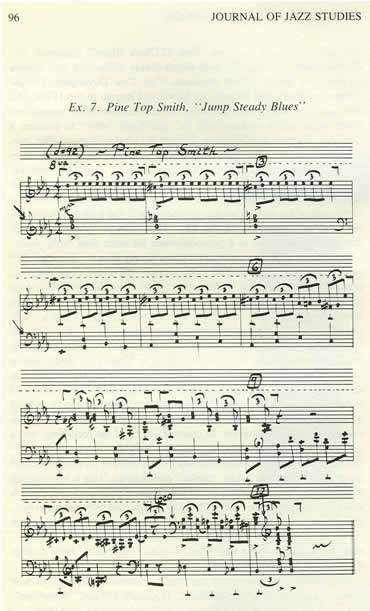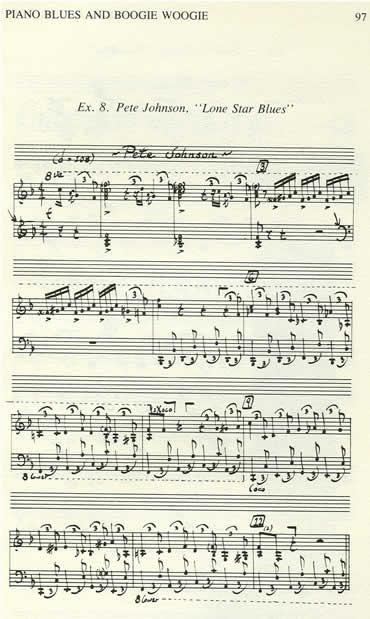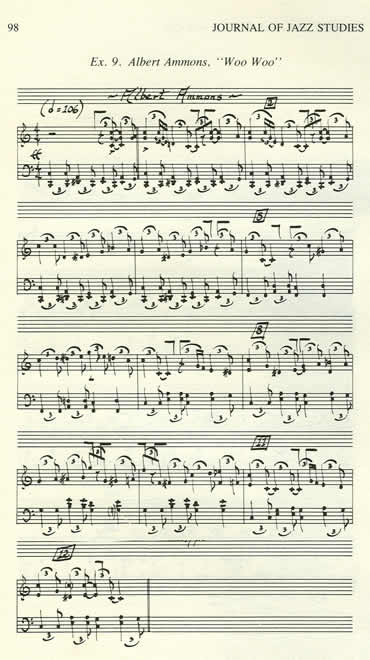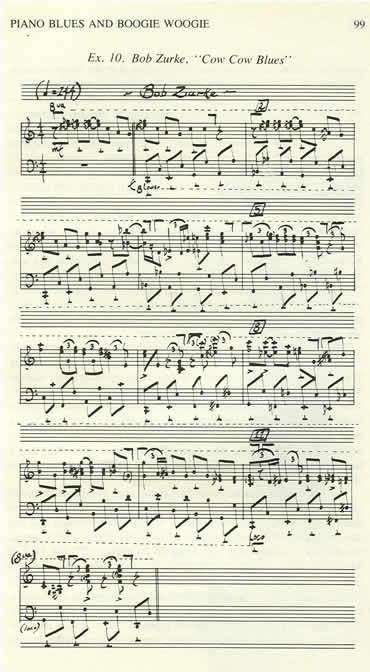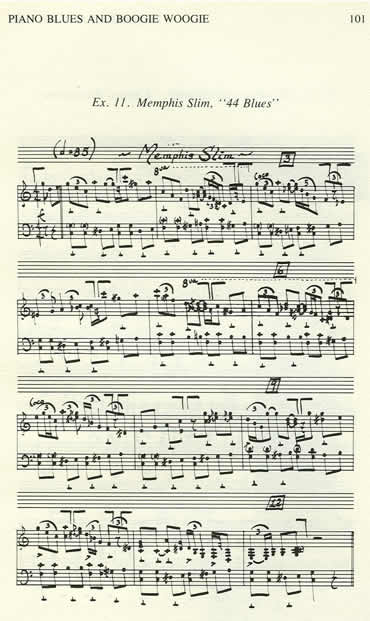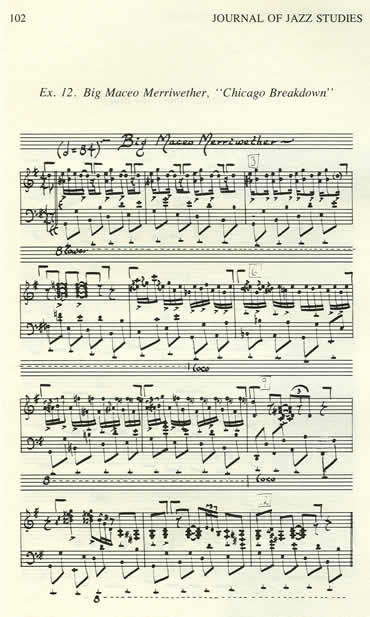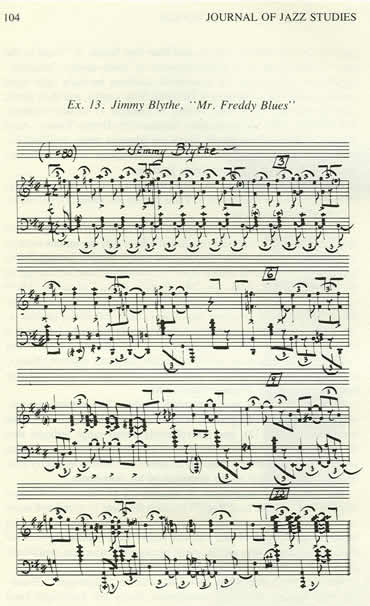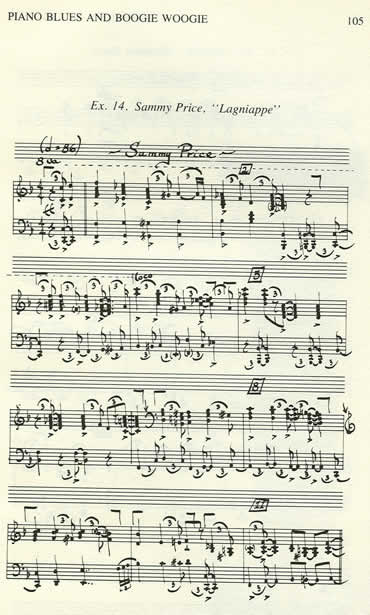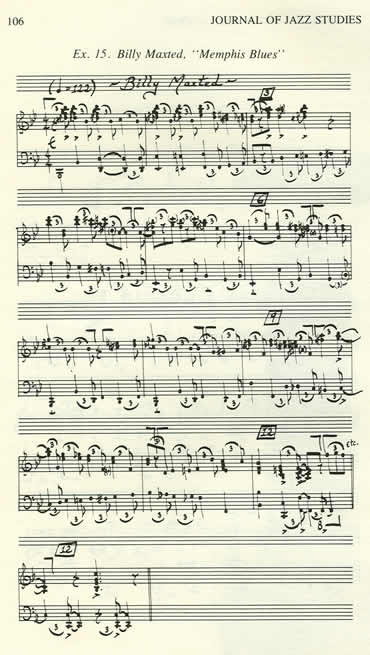Archetypes and Antecedents of Piano Blues and Boogie Woogie Style
Articles and Scholarship — Thu, May 08, 2008
This article was written and provided by Eli H. Newberger, M.D. and was originally printed in the Journal of Jazz Studies 1976; 4:84-109. and reproduced here with permission.
Jazz is essentially an improvised music; it is simultaneously composed and performed. "Style" in jazz implies qualities of both composition and performance. "Idiom," "structure," "phrasing," and "technique" are aspects of style, and a study of various jazz styles contrasts musical "personalities" in the fullest sense.
The jazz piano is as old as jazz, and there have been as many jazz piano styles as there have been jazz pianists. Some, however, seem to show particular originality and imagination, and their work has been of influence. The piano blues stylists to whom one can look as archetypes for the piano blues and boogie-woogie school share these attributes.
In general, the performers represented here exhibit an impressive technical command of the piano. This is not a prime requisite for the effective use of the instrument in jazz, however. For that reason, Cripple Clarence Lofton is present, while, for instance, José Iturbi is not.
To capture a sense of style, and to demonstrate the characteristic features of this school of jazz pianism, each of the artists discussed in this article is represented by a typical 12-bar blues improvisation. Principal conceptual and methodologic issues pertaining to the transcription and notation of these choruses are reviewed in a previous study. 1
As did ragtime, piano blues and boogie-woogie derived from many sources. But where ragtime shows in its notated music and its mannered style the manifest influence of nineteenth century European and American "light classical" music, the earthy, gutty vitality of "the blues" partly obscures an earlier, if no less profound, exposure of the West African slave to the religious music of white America.
Consider for a moment that the music of West Africa was, and is only recently acknowledged to be still, a highly sophisticated and traditionalized unwritten form. Certain scales, modes, and rhythmic configurations pertain to particular tribes, regions, secular and ritual functions. 2
Tone-color and inflection are quite important, and there is a highly elaborated correspondence between language and musical sound. Tuned drums, so-called "talking drums," and constantly tunable drums complement a wide variety of percussion and wind instruments which are frequently pretuned to, say, a basic pentatonic or seven-note scale. Simply stated, the governing principles of the music of West Africa are polyphony, relationship of the number of notes in the mode or scale to the rhythmic structure, theme and repeated variations.
Marshall Stearns’s chapter on the American background of jazz dates the "mass blending of the two musical traditions of Europe and West Africa" to around 1800, the time in which the Methodist revival movement known as "The Great Awakening" was gathering momentum. He notes, too, that black preachers—such as Black Harry, who accompanied Bishop Asbury, a founder of the Methodist Church, in his travels—were known before the American Revolution, and that "lining out"—the practice in early New England congregations of answering and embellishing a reader’s chanted or spoken verse, a custom "which lent itself so easily to the West African call-and-response pattern’‘—can be traced back to 1644, when "the Westminster Assembly recommended the adoption of the practice in English churches because the congregation couldn’t read."3
Musical artifacts of the dynamic exchanges which took place between black and white revivalists may yet be heard in black gospel music, a vivid expression of the "black aesthetic," 4 and such white churches as the Holiness Faith Healers. The music of both contains many elements which are central to blues: antiphonal "exchange" between preacher and congregation; repeated rhythmic patterns or "riffs"; and spontaneous improvisations on the words or melody to a hymn. Two quotes from Hear Me Talkin’ to Ya’ perhaps better make the point." 5
Danny Barker says of Bessie Smith:
Bessie Smith was a fabulous deal to watch. She was a pretty large woman and she could sing the blues. She had a church deal mixed up in it. She dominated a stage. . . . If you had any church background, like people who came from the South as I did, you would recognize a similarity between what she was doing and what those preachers and evangelists from there did, and how they moved people. The South had fabulous preachers and evangelists. Some would stand on corners and move the crowds from there. Bessie did the same thing on stage. . . Bessie was in a class with those people. She could bring about mass hypnotism.
And T-Bone Walker of the blues:
The blues? Man, I didn’t start playing the blues ever. That was in me before I was born and I’ve been playing and living the blues ever sInce. . . . Of course, the blues comes a lot from the church, too. The first time I ever heard a boogie-woogie piano was the first time I went to church. That was the Holy Ghost Church in Dallas, Texas. That boogie-woogie was a kind of blues, I guess. Then the preacher used to preach in a bluesy tone sometimes. You even got the congregation yelling" Amen" all the time when his preaching would stir them up—his preaching and his bluesy tone. Lots of people think I’m going to be a preacher when I quit this business because of the way I sing the blues. They say it sounds like a sermon.
Certainly, too, the work song, the field holler, and the later guitar-accompanied "country blues" contributed to what eventually became piano blues and "boogie-woogie." The special pertinence of blues to the black experience shaped this communication. 6
In Speckled Red’s chorus on "Wilkins Street Stomp" (Example 1),7 we note, in addition to a formal, chordal "introduction," a striking right hand device between measures 4 and 10. Alternation of intervals and chords with single notes in a limited range produce an easy ostinato, not unlike a strummed, subtly changing blues solo on the guitar.
With urbanization after the abolition of slavery came the integration at the piano of such diverse elements as the rapid, chugging guitar rhythms of "Fast Western" blues, presumably from the oppressive lumber and turpentine camps; the melancholy "spirituals"; the fervent, frantic "jubilees" and "shouts"; and to a lesser extent, as we see in Cow Cow Davenport‘s solo on "State Street Jive" (Example 2)8, ragtime. Davenport’s performance shows an unusual number of right hand octave and "pivot" figures. His is a barrelhouse style with extreme emphasis on repetition and embroidery; in each chorus in the present recording, the left hand is nearly identical and the right hand incessantly decorates with grace notes, passing voices. and "ragged" eighth notes. Adding further to the "ragtime" sense is the unusual formally repeated "middle section" (measures 5 to 9) which is similarly rarely altered.
The uncommonly fine left hand pattern begins with powerful octaves which migrate into a stunning chromatic run (measures 5, 6). Thereafter broken fifths and a two-measure riff (measures 9 and 10) provide a rocking, shifting accompaniment.
Yet it is notable that Davenport’s cut of "Atlanta Rag"9 sounds as if he is shackled by the ragtime manuscript. There is much the same "eight to the bar" feeling as in the present example, but we have the impression that the performer needs more freedom to improvise.
In addition to its several sundry other meanings, "blues" came later to mean "12-bar blues," the standard three-chord scheme we hear so eloquently improvised in these pages. Stearns remarks that W. C. Handy’s popular "Memphis Blues" was turned down several times because of its "unusual" form before it was published in 1912. And Count Basic. leader of the splendid band that "swings the blues," first heard that "blues" meant only "12-bar blues" in Oklahoma City in 1926 from the celebrated blues singer Jimmy Rushing. who in turn had been so taught by an uncle from the deep South around 1915.10
In Hear Me Talkin’ to Ya’ Bunk Johnson, among others. talks of the blues in New Orleans around the turn of the century:
That was the Crescent City in them days, full of bars , honky-tonks. and barrel houses. A barrel house was just a piano in a hall. There was al ways a piano player working. When I was a kid, I’d go into a barrel house and play ‘long with them piano players ‘til early in the mornin’. We used to play nuthin’ but the blues.11
And Jelly Roll Morton, in the narrative accompaniment to his Library of Congress recordings,12 speaks often of hearing very many solo blues pianists in Storyville whose inventiveness (by Morton standards) might be called into question but who nonetheless improvised original variations.
Perhaps Morton’s objection to the blues he heard had to do with the fact that the melodies in that idiom—particularly in the faster pieces—differed markedly from those which he heard in, say, ragtime and instrumental popular music. For where ragtime’s melodic figures are maintained steadfastly throughout the "piece," altered, perhaps, by grace notes, passing voices, and a rare extra syncopation, such blues as Cripple Clarence Lofton‘s eleven-bar "Blue Boogie" (Example 3),13 and Meade Lux Lewis‘s slower "Far Ago Blues" (Example 4) 14 (admittedly recorded much later by men whose personal styles Morton could not possibly have heard in New Orleans) show "melody" taking form from a few repeated rhythmic figures, or "riffs," such as we hear in measures 1 and 3 in Lofton’s chorus and in measures 6 and 10 in Lewis’s. Generally there are three four-measure phrases in a blues. The 12-bar whole is frequently "filled out" by repetition, chords, and occasional arpeggios or by simply allowing the underlying bass pattern (or, as in Lewis’s solo, bass "line") to carry on alone.
Lofton and Lewis spent much of their lives in Chicago, a city which attracted and produced many superb blues players. There, in fact, began the public renaissance of "boogie-woogie" in the late 1930s and early 1940s prompted by the rerecording of Lewis’s popular" Honky Tonk Train Blues" of 1929 (after, as Leonard Feather reports,15 he was found by critic John Hammond washing cars in a Chicago garage) and by Pine Top Smith‘s splendid "Pine Top’s Boogie-Woogie" of 1928. Lewis, in fact, was one of the major figures of that period, while Lofton, whose tolerant ear and penetrating lack of technical discipline produced many dissonances (such as one hears in measures 1, 2, 7, and 8) and such eleven-bar choruses as this present solo, remained always in relative obscurity.
Montana Taylor was even less known to the general public, having "disappeared" after completing the very productive session from which his solo on "Detroit Rocks" (Example 5)16 was taken. This chorus clearly presents what came to be the archetypal features of popular "boogie-woogie": steady ostinato accompaniment, repeated riffs and triplet patterns, truncated phrases, and simple harmonies. Such right hand ninths as these in measures 4, 6, and 8 are not "atypical," as they inevitably resolve. The clean lines and directness of the chorus are accentuated by a virtual absence of dynamic variation.
Jimmy Yancey is a name that is rather more familiar than Montana Taylor, although ironically he seems to have been publicized mainly by Meade Lux Lewis‘s and Bob Crosby’s recordings of "Yancey Special" in 1936 and 1938, respectively. Subsequently he himself did record, and his solo on "The Fives" or "Five O’Clock Blues" (Example 6)17 displays many features of a style which deeply influenced such figures as Pine Top Smith, Albert Ammons, Cow Cow Davenport, Cripple Clarence Lofton, and Meade Lux Lewis in Chicago in the 1920s. We note a lusty, rocking bass with intervals and accents on the second and fourth beats which contrast with the right hand "riffs" to produce a dazzling series of cross-rhythms through the chorus. Remarkable, too, are such subtleties as dynamic modulation in measure 8 and integration of the "melody" into chords in measures 1, 2, 5, 6, 11, and 12. Yancey’s "slow blues" style was perhaps less raw-boned, though surely as transitive and expressive. He also indulged in a peculiar ritual at the ends of his various works, cadencing in E-flat with an idiosyncratic signature regardless of the key. The Chicago White Sox were fortunate to have him as a groundskeeper for more than thirty years.
Pine Top Smith‘s recording of "Jump Steady Blues" (Example 7)18 reveals a debt to Yancey. This is the second chorus from that performance; it differs in a few important respects from the first. The third measure, hitherto part of the main body of the chorus, becomes an extra introductory measure; where the bass pattern had begun occurs a single chord, and the feeling of phrasing changes accordingly. Between the first beat of measure 4 and the last beat of measure 8, left hand fifths happen on thesecond beat, somewhat as in Yancey’s chorus, with a single exception, thefourth beat of measure 7. The rhythmic variety in the second half of the chorus is still more impressive for conflicts of "triplet" and nearly "straight" eighth notes in measures 7 to 10. A kind of rhythmic resolution takes place in the last two measures, which arc entirely in "triplet" rhythm. In contrast. much of the recording, and a great deal of Pine Top’s playing, has the chugging, "eight-to-the-bar" feeling which to some extent derives from a relative preponderance of more nearly "straight" than "triplet" eighth notes. This is a prominent rhythmic feature of much of the instrumental rhythm-and-blues which stemmed from the same roots as boogie-woogie and which may, in fact, also be seen as a form of "the blues." Just as ragtime sprang in part "from the gutters of Vienna" and contributed some few "African" roots to the songs of Tin Pan Alley, so does "the blues" have its later offspring in rock music today.
Pete Johnson of Kansas City and Albert Ammons of Chicago, in their respective solos on "Lone Star Blues" (Example 8)19 and "Woo Woo" (Example 9)20 play primarily single-note improvisations over their bass patterns, a technique which was widely imitated in the boogie-woogie "revival" by such ersatz practitioners as Freddie Slack and Honey Hill.
While piano blues and boogie-woogie are traditionally played solo—the ostinato left hand presumably supplanting a "rhythm section"—such bands as Bob Crosby’s and Ray McKinley’s played arrangements of boogie-woogie "numbers" in the 1930s, employing some capable pianists to handle the piano chorus but—with notable exceptions, as will be seen in Bob Zurke’ s solo—diluting the intensity and feeling of "blues." Ammons and Johnson, however, each played with bands at various times, the former frequently with drums and bass (the present solo was notated from such a recording), and the latter enjoying success in the late 1920s with the excellent blues singer Joe Turner, whom he met when Turner was tending bar at Piney Brown’s Sunset Cafe in Kansas City. Their styles sharing a certain adroit unsubtlety and tendency to play’ ‘triplet" rather than more nearly "straight" eighth notes, they joined forces to make many vigorous two-piano appearances in clubs and on discs during the boogie-woogie "revival," and, in fact, played and recorded some surprising three-piano boogie-woogie with Meade Lux Lewis in New York in that time.
When Bob Zurke succeeded Joe Sullivan in the Bob Crosby Band in 1936, he played both a "swing" style which seems derived from Fats Waller, Earl Hines, and Teddy Wilson, and the powerful, sincere boogie-woogie which we hear on "Cow Cow Blues" in Example 10.21 After achieving such a measure of popularity as a boogie-woogie player in the late 1930s that he won the Down Beat poll in 1939, he attempted a band of his own which failed. Like very many other jazz pianists—notably Pine Top Smith, who never lived to hear his "Pine Top’s Boogie-Woogie" played far and wide—Zurke lived the last years of his short life in obscurity.
Two singer-pianists who worked in Chicago and also did some superb accompaniment for such more famous shouters as Big Bill Broonzy and Sonny Boy Williamson are Memphis Slim (Peter Chatman) and Big Maceo (Major) Merriwether, whose solos on "44 Blues" and "Chicago Breakdown," respectively, are heard in Examples 1122 and 12.23 If Memphis Slim’s recorded work gives the impression of being less powerful than Big Maceo’s—the latter’s chorus is singular for savage intensity and devilish virtuosity—their styles show special similarities. Each develops tension over a number of choruses, employing progressively growing patterns or relentlessly repeated "riffs" over a more-or-less unchanging ostinato bass. One feels that the sense of rhythm in their playing, as with Jimmy Yancey and Pine Top Smith, is "eight to the bar," consequent of a preponderance of more-nearly-"straight" eighth-note types (note the remarkable conflicts between right hand triplets and left hand couplets in Memphis Slim’s solo), and their works share an unusually deep blues feeling. In Example 11 we hear evidence that Memphis Slim was particularly influenced by Jimmy Yancey. As in Yancey’s chorus (Example 6), there are frequent turns, conflicts between accompaniment eighth notes and treble triplets, fourths and fifths in the left hand, and concise treble patterns.
Bob Zurke’s solo (Example 10) has much of the same churning, thrusting quality of Big Maceo’s. Their mighty left hands, furthermore, sound virtually identical.
Three versatile musicians whose financial needs have brought them through many bands and many styles but whose riffy inventions seem to reveal fundamentally "blues" spirits are Jimmy Blythe, Sammy Price, and Billy Maxted. Only Blythe spent an amount of time in Chicago in the 1920s, but his chorus on "Mr. Freddie Blues" (Example 13),24 unlike Price’s and Maxted’s, shows an abundance of ragtime figures which perhaps belie his close exposure to such influential pianists as Jimmy Yancey. He uses right hand pivot notes in measures 1-4 and 6, a modified two-beat bass in measures 5, 8, and 10, and a kind of rag "release" into measure 5. At the same time his short, discrete phrases, repeated right hand patterns, and heavy, continuous left hand pay homage to the other Chicago blues artists.
Blythe’s solo has a special pianistic quality. The various accents, octaves, left hand anticipations and chords, ornaments, pedal points (measures 11 and 12), and his relatively broad range indicate that Blythe, like many of the blues players and such post-ragtimers (who seem to have affected his playing) as James P. Johnson and Jelly Roll Morton, was attentive to the resources of his instrument.
The syncopated progression in measure 12 of Morton’s "Correct Version" of "Maple Leaf Rag"25 is much the same in sound and sense as the chord series in measure 7 here. Jimmy Blythe, like Johnson and Morton, spent most of his musical career as a soloist. His varied rhythms, willingness to use the entire piano, and exceeding confidence set him apart from many ensemble pianists.
Sammy Price’s bellowing, two-fisted solo on "Lagniappe" (Example 14)26 features incessant syncopation, hearty left hand-right hand exchanges (measures 5, 6), and heavily accented chords. But neither is Price’s left hand a strictly ostinato affair, and like Jimmy Blythe’s, his feeling of time is not always 4/4. The background in this chorus shifts from octaves (measure 1) to stride (measure 2) to chromatics (measures 3,4) to patterns (measures 7,8). His left hand coordinates with his right to outline passing harmony and to shape phrases. And the rhythm charges ahead of or lags behind the strong beats, which, as in measures 2, 3, 4, and 6, are frequently enough the first and third beats to convey a sense close to 2/4 time.
Billy Maxted’s small stature may have much to do with the preponderance of right-hand-fitting chords and intervals in his solo on "Memphis Blues" (Example 15).27 His left hand, furthermore, appears to lean toward linear, chromatic, and within-the-octave patterns. Nonetheless Maxted plays with impressive power, harkening to Bob Zurke, whose hefty unsubtlety and crisp phrasing he shares. Maxted is a pianist whose versatility enables him to sustain an association with the artists and places of New York "dixieland" (he worked at Nick’s both alone and with ensembles for many of the club’s last years). He plays fine, rich blues, similar in many respects to Meade Lux Lewis‘s and Jimmy Yancey’s.
Blues and "boogie-woogie," like ragtime, contributed a certain basic quantity to the evolution of the jazz piano. In the hands of the "New Orleans" and "Stride" pianists, a synthesis of sorts took place. Bluesy patterns and "riffs" came often to be played by, say, Fats Waller, over typical ragtime basses; and, conversely, such artists as Eubie Blake display ragtime-derived decorations and traditional melodies over standard ostinato blues accompaniments.
Often members of ensembles rather than soloists, pianists adapted their styles to integrate with their rhythm sections. They supported other players and had only a chorus or two to impart their message to the audience. So their styles grew, and changed.
NOTES
I. E. Newberger. "The Transition from Ragtime to Improvised Piano Style,"Journal of Jazz Studies 3. no. 2 (Spring 1976): 3-18.
2. The relationships of the performers themselves, as well as the music, to the structure and social life of West African societies, are treated by S. Kinney, "Drummers in Dagbon: The Role of the Drummer in the Damba Festival,"Ethnomusicology 14 (May 1970): 258-65; and D. W. Ames, "Igbo and Hausa Musicians: A Comparative Examination,"Ethnomusicology 17 (May 1973): 250-78.
3. M. Stearns,The Story of Jazz (New York: Oxford, 1956), chap. 8.
4. "Gospel has distilled the aesthetic essence of the black arts into a unified whole. It is a colorful kaleidoscope of black oratory, poetry, drama and dance. One has only to experience a gospel ‘happening’ in its cultural setting to hear black poetry, in the colorful oratory of the black gospel preacher, or to see the drama of an emotion-packed performance of a black gospel choir interacting with its gospel audience, and the resulting shout of the holy dance. It is indeed a culmination of the black aesthetic experience." P. Williams-Jones, "Afro-American Gospel Music: A Crystallization of the Black Aesthetic,"Ethnomusicology 19 (September 1975): 373-385.
5. N. Shapiro and N. Hentoff, eds.,
Hear Me Talkin’ to Ya (New York: Rinehart, 1955), pp. 243, 249-51.
6. "It is interesting to compare the popularity of blues (which stressed suffering) among Blacks with that of black-face minstrel songs (which stressed the simple happiness of blacks), performed widely before white audiences. (Footnote: This difference is roughly comparable to the division between the ‘Uncle Remus’ tales which were projected at white audiences and the more obscene protest tales which circulated only among Blacks.) Each performance was directed toward a racial audience, and their differences suggest the dilemma of the black musician who performed for both white and black audiences. It is clear that the same materials would not be appropriate for each, and thus two distinct repertoires developed." W. R. Ferris, Jr., "Racial Repertoires among Blues Performers,"Ethnomusicology 14 (September 1970): 439-449.
A rich and vivid scholarly study of the meaning of blues—and wry and trenchant commentary on blues scholarship—is found in Charles Keil,Urban Blues (Chicago: University of Chicago Press, 1966). Individual players’ styles can be understood in reference to the social and cultural contexts of their lives, to definable geographic regions, and, importantly, to the changing demands and tastes of the musical marketplace. One scholar’s perceptions of the whole panoply may draw from lyrics in the country idiom: ". . . mules, boll weevils, highways, trains, boxers, prisons, hurricanes, floods, bloodhounds, lawyers, chauffeurs, Pearl Harbor, fire departments, cities, rivers, gambling, beer, whiskey, voodoo, sex," (p. 70), where "In the later city blues styles, like those of the best-known Chicago singers at the present time, the accent is either on bravado and virility or—conversely—helplessness" (p. 71).
7. Brunswick 50414. Recorded in Memphis, Tennessee, January 24, 1929.
8. Brunswick 50414. Recorded in Chicago, July 16, 1928.
9. Riverside SDP 11. The influence of ragtime on piano blues is attributed by Paul Oliver inThe Story of the Blues (Radnor, Pennsylvania: Chilton, 1969) both to the deep ragtime tradition in such cities as St. Louis and Indianapolis (p. 80) and to the generation of the artist: "It is noticeable that the first generation, born a decade later, were exclusively blues players. Most of them seemed to have met at some period in their formative years" (p. 83). Charles Cow Cow Davenport was born in 1894 in Anniston, Alabama, and was "expelled from seminary for playing ragtime," according to biographic notes by Leonard Feather inThe Encyclopedia of Jazz (New York: Bonanza, 1962).
10. Stearns,Story of Jazz, pp. 105-106.
11. Shapiro and Hentoff,Hear Me Talkin’ to Ya, p. 7.
12. A. Lomax,Mister Jelly Roll (New York: Grosset and Dunlap, 1953).
13. Riverside SDP 11. Recorded in Chicago, 1939.
14. Riverside SDP 11. Recorded in New York, 1939.
15. L. Feather,The Encyclopedia of Jazz (New York: Bonanza Books, 1962).
16. Brunswick 50414. Recorded in Chicago, April 23, 1929.
17. Riverside SDP 11. Recorded in Chicago, 1939.
18. Brunswick 50414. Recorded in Chicago, January 14, 1929.
19. Riverside SDP 11. Recorded in New York, April 16, 1939.
20. Columbia CJM 1013. This is a chorus from an ensemble recording led by Harry James.
21. Columbia CJM 1013. Recorded in Chicago, May 8, 1940.
22. Folkways FG 3524. Notes for this 1959 release by Charles Edward Smith, which do not list a recording date, state: "Slim believes this special and original style of playing was created by a man called Ernest ‘Forty-Four.’ The lyrics, not sung on this record, involve a faithless woman and a 44-calibre pistol."
23. RCA LPM 2321. Liner notes by George T. Simon date the recording to 1945. It includes sidemen Tampa Red, guitar, and Charlie Sanders, drums.
24. RCA RLP 1031. Recorded in Chicago, 1926.
25. Newberger, "Transition from Ragtime," pp. 13-14.
26. Jazztone J 1213. This is a chorus from an ensemble recording led by Omer Simeon.
27. Decca 8282. This is a chorus from an ensemble recording led by Eddie Condon.
Eli H. Newberger is writing several articles as part of a larger study on the evolution of jazz piano styles. At Children’s Hospital Medical Center, Boston, he is director of the Family Development, Study. He is also assistant professor of pediatrics at the Harvard Medical School.



